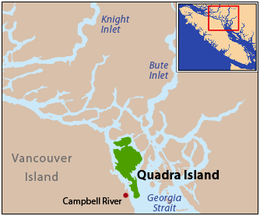Quadra Island

Quadra Island is located at the northern end of the Strait of Georgia.
|
|
| Geography | |
|---|---|
| Location | Strait of Georgia |
| Coordinates | 50°10′N 125°14′W / 50.167°N 125.233°WCoordinates: 50°10′N 125°14′W / 50.167°N 125.233°W |
| Archipelago | Discovery Islands |
| Area | 310 km2 (120 sq mi) |
| Administration | |
| Province | British Columbia |
| Demographics | |
| Population | 2472 (2006) |
| Ethnic groups | Laich-kwil-tach |
Quadra Island is an island off the eastern coast of Vancouver Island, British Columbia, Canada, part of the Discovery Islands located within the Strathcona Regional District. Quadra Island is about 35 kilometres (22 miles) from its northernmost point to its southernmost point. The island at its narrowest point, on its southern peninsula, is less than 2 km (1.24 mi) wide, and at its widest point, about 15 km (9 mi) wide. In area Quadra island comprises about 310 square kilometres (120 square miles). The population of island and surrounding mainland inlets, as of the 2006 federal census (excluding First Nations Reserves, tallied separately), was 2,472, down from the 2001 federal census count of 2,548. In 1903 it was named after the Spanish navigator Juan Francisco de la Bodega y Quadra, who explored and settled the Vancouver Island area in the late 18th century. It is separated from Vancouver Island by Discovery Passage, and from Cortes Island, and is linked to that island by a ferry from Heriot Bay on its eastern shore. The island has many beaches, trails, lakes, and parks. Main Lake Provincial Park is located on the northern part of the island, and Rebecca Spit Marine Provincial Park is on the eastern shore, near Heriot Bay.
Few of the island's soils are well suited to agriculture. Most are coarse and, in well-drained areas, have classic podzol profile development; they are mapped as Kye loamy sand and Quinsam gravelly sandy loam. A small area of dark well-drained unpodzolized soil (Lazo loamy sand) is mapped around the southeast corner. Dashwood gravelly loamy sand, a brown podzolic trending to podzol, is commonly associated with Kye and Quinsam. Imperfectly drained areas have brown podzolic Bowser loamy sand or classic podzol Sayward loamy sand. The more moist Custer loamy sand is present locally. Poorly drained areas have Arrowsmith peat, Parksville sandy loam, or Tolmie loam (the latter two are gleysols).
...
Wikipedia
